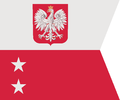| Image | Date | English name
Polish name | Use |
|---|
 | 1996 | Police flag
Flaga Policji | Police vessels (from 2 May 1996) [11] |
| Special state service flags (below) are used by state-employed civil special-purpose ships while on duty, from 16 December 2005. These flags all follow the same basic design; a white flag with a horizontal stripe 1/5 the width of the flag's width. In the middle, each flag is emblazoned with the national coat of arms superimposed on a golden or yellow anchor whose height is 3/5 of the flag's width. The middle stripe is broken in the middle and does not touch the anchor or the arms. The type of special service performed by the ship is indicated by the color of the middle stripe. Proportion 5:8. [12] From 1967 there were basically similar flags carried, but with PRL coat of arms (eagle without a crown) [13] |
 | 2005 | Hydrographic survey and Maritime Office flag
Flaga statku hydrograficznego i dozorczego urzędu morskiego | Hydrographic survey vessels and vessels of Maritime Offices (blue stripe) |
 | Rescue ship and pollution-control flag
Flaga statku ratowniczego oraz specjalnego statku do zwalczania zanieczyszczeń | Lifeboats and pollution-control vessels (orange stripe) |
 | Icebreaker flag
Flaga statku używanego wyłącznie do łamania lodów | Vessels used exclusively for breaking ice (violet stripe) |
 | Pilot boat flag
Flaga statku pilotowego | Pilot boats (ash-grey stripe) |
 | Fireboat flag
Flaga statku pożarniczego | Fireboats (red stripe) |
 | Training ship flag
Flaga statku szkolnego | Training ships (black stripe) |
 | Customs ship flag
Flaga statku celnego | Customs ships (green stripe) |
 | Hospital ship flag
Flaga statku sanitarnego | Hospital ships (yellow stripe) |
 | Telecommunication ship flag
Flaga statku telekomunikacyjnego | Telecommunication ships (brown stripe) |
 | | Flag / ensign of the Maritime Search and Rescue Service Flaga / bandera / znak armatorski: Morska Służba Poszukiwania i Ratownictwa (MSPiR) | Flag of the service |
 | 1967 | Hydrographic survey and Maritime Office flag
Flaga statku hydrograficznego i dozorczego urzędu morskiego | Hydrographic survey vessels and vessels of Maritime Offices (blue stripe) |
 | Rescue ship and pollution-control flag
Flaga statku ratowniczego oraz specjalnego statku do zwalczania zanieczyszczeń | Lifeboats and pollution-control vessels (orange stripe) |
 | Icebreaker flag
Flaga statku używanego wyłącznie do łamania lodów | Vessels used exclusively for breaking ice (violet stripe) |
 | Pilot boat flag
Flaga statku pilotowego | Pilot boats (ash-grey stripe) |
 | Fireboat flag
Flaga statku pożarniczego | Fireboats (red stripe) |
 | Training ship flag
Flaga statku szkolnego | Training ships (black stripe) |
 | Customs ship flag
Flaga statku celnego | Customs ships (green stripe) |
 | Hospital ship flag
Flaga statku sanitarnego | Hospital ships (yellow stripe) |


























































